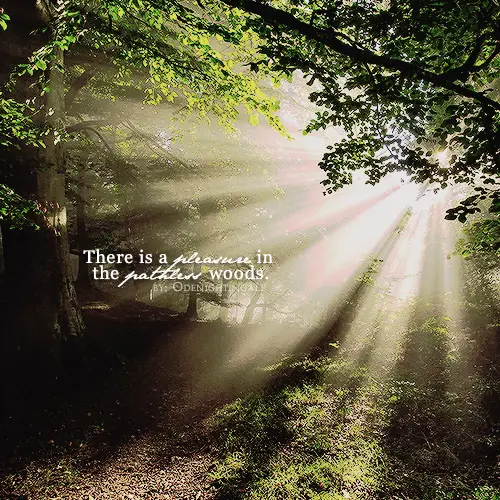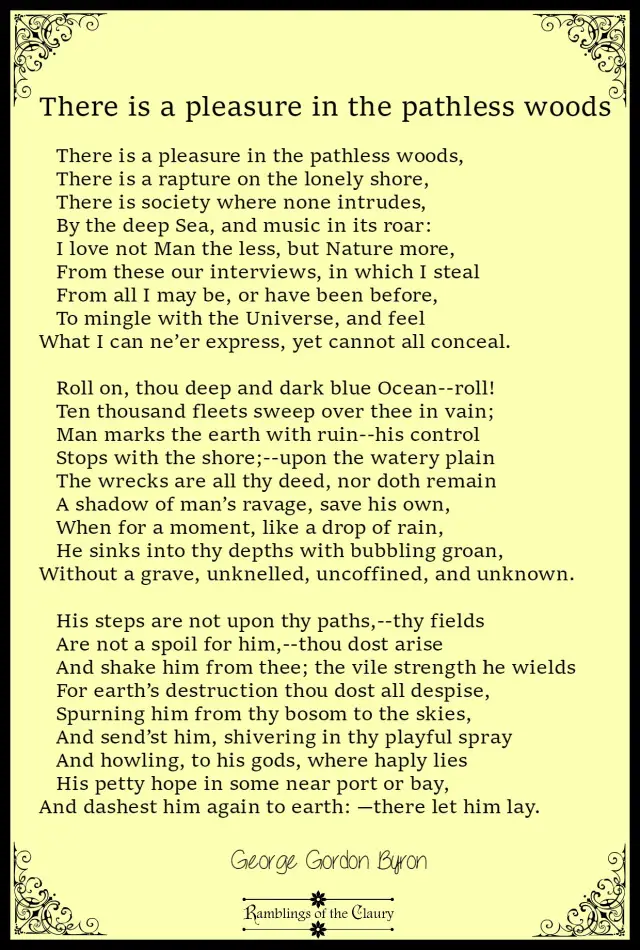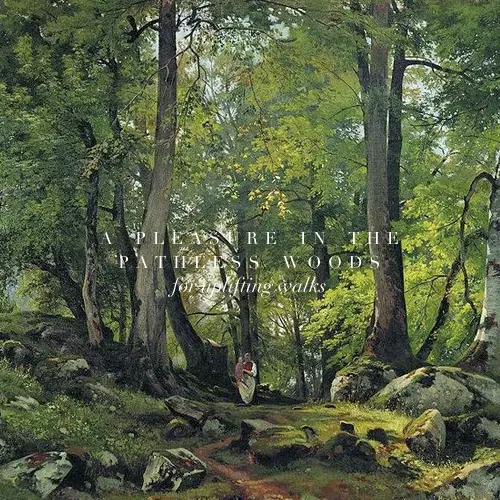“She Walks in Beauty Like the Night: There is Pleasure in the Pathless Woods” is known as a classical poem that was written between 1815 to 1817.
Table of Contents
There is Pleasure in the Pathless Woods Year
In this poem, Lord Byron gives a title that can let the readers think after reading the first time that he is talking about his beloved. The story speaks about a beautiful woman and in the next segment,
What is the poem about?
“There is Pleasure in the Pathless Woods” Lord Byron explains of exploration of new places. The main thing about the poem is the beauty of nature. This is a full Romantic poem.
The theme of The Poem
The title of the poem speaks on a deep pathos of finding a lonely woods. There are happiness and joy in walking in Pathless woods.
The idea of “Romantic Poetry” can be found in the poem and loneliness, emptiness is being shown throughout the poem.
There is Pleasure in the Pathless Woods Summary
Here, the poem presents nature in his own way. In the beginning, readers will be able to find that he is describing the sea and shore. After that, he suddenly changes the image of nature.
And now, he started speaking that nature kills a man who never any wrong to the sea. And the man goes back to God by leaving the earth.
The last segment is very significant and melancholic because the man had hope in his life that he can not fulfill. And later, he went back to God where he will get peace.

There is a pleasure in the pathless woods analysis
In the very first lines, poet is repeating the title as a line that speaks poem went somewhere and finds the pleasure of loneliness while he was walking through woods.
There is a Pleasure in the Pathless Woods There is a Rapture on the Lonely Shore
And suddenly poem finds a raptured shore on the path and society does not know the path.
“There is society where none introduces”
Interest in exploration is being shown here. Lord Byron as a counsel of human society comes in the woods and that is why he is exploring nature by his poetry. Nature is not calm because the shore of deep-sea comes and goes back.
What Does There is Pleasure in the Pathless Woods Mean?
Here the poet is finding a piece of music is the breaking shore and on the lonely beach, it seems like the shore.
“I love not Man the less, but Nature more,”
This line speaks that poet does not hat man but he loves the ‘Nature’ more than this. Maybe poet is trying to find nature in a new way of ‘Romanticism’. Then he takes a reference to their interviews that the poem had stolen.

Now he is enunciation that from these all finding a new land is more joyous. And the poet’s nature is very beautiful that poem can never explain in words.
There is Pleasure in the Pathless Woods Critical Analysis
Now, poet is asking the nature to roll on its shore where the dark blue ocean is lying making the poet romantic. Addressing the nature as ” thee” he states,
“Ten thousand fleets sweep over thee in vain;”
Ten thousand wounds are being cured soon that people made in the vain nature. And people ruin the world and grasps the shore. Now the poet is saying the sea stop shooting over the plain sands. The shore is devastating and that is poet utters to stop shooting as it had made destruction by the deed.

Man is being destructed and the shadow can be seen there. The man is saving himself from the destruction. For a single it drops in the soil like rain is falling down. The man sinks into the depth of the ocean from where the bubbles are growing.
The man is unknown, no one knows him that is unknelled, uncoffined. So, the second stanza ends here with an epistle where directly poet is not saying anything.
There is Pleasure in the Pathless Woods Quote
The third stanza opens with another imagery where he is saying,
“His steps are not upon thy paths, thy fields
Are not a spoil for him, thou dost arise”
Here, these lines speak that the man is not following the path of all humankind. And people make destruction towards nature but the path of the change where nature lives in its way and the man never harmed it.
He arises and slashes himself for the shore of nature and he drives with the vile strength. Nature’s destruction let mankind think that it is devastating.
People of the world are thinking about nature and the steps ahead for devastation. But nature plays a devastating role because it spurns the man from its bosom to the sky. That means here, nature kicks out the man from the world and send him to heaven as the man dies.
“And howling, to God, where happy lies
…And dashest him again to earth: there let his lay.”
Perhaps the line symbolizes that the man is howling and gets back to god where happiness stays and that is why the man, who died will also stay at peace.
Childe Harold’s Pilgrimage there is a Pleasure in the Pathless Woods
The man had hope near the port. The man dashed him from the earth to heaven and poet is saying to let him stay there in peace. So, the whole story has several images and the last part is a bit of melancholy because the man dies who never harmed the sea.
Rhetorical Devices
The poem has a rhyme scheme that is,”ababbcbcc”. The first stanza of the poem had been written in this form. Except that there are several imageries like, “deep sea”, “ocean roll”, “pathless woods”,”bubbling”, etc.
There is Anaphora that means, repetition of a word in two lines one after another at the starting of the line.
“There is a pleasure in the Pathless woods,
There is a rapture on the lonely shore,
There is a society where none intrudes,”
Questions from Readers
Who said there is pleasure in the Pathless woods, there is…?
The poet, Lord Byron said there is pleasure in pathless woods.
What does there is pleasure in the Pathless woods means?
Here, pleasure in pathless woods means not following the footsteps of men walk in own way which is joyous.
What is there in pleasure in the Pathless woods, there is?
There is a dark, blue sea beside the woods
What I can ne’er Express yet cannot all conceal?
The deep pathos can not be explained.